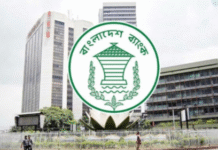
The key indicators did well in 2017 amid a seemingly stable political atmosphere throughout the year, but the economy took a hit on spiralling rice prices and a messy banking sector.
Analysts, however, raised concerns over increased rice import and soaring prices following two rounds of floods and lack of supervision in the banking sector.

But former governor Mohammed Farashuddin and economist Ahsan H Mansur described the outgoing year’s economy ‘good on the whole’.“The GDP had grown by over 7 percent for two years, economic indicators are doing well, the Padma Bridge construction is going ahead and the power generation has increased, which are all good things…Bangladesh will march at double speed in 2018,” said Farashuddin, who headed the central bank between 1998 and 2001.
Soaring rice prices, however, left mid- and low-income group in trouble, said Mansur, Executive Director of private think-tank Policy Research Institute. “The government failed to handle it efficiently.”
Growth, revenue and forex
The size of Bangladesh’s gross domestic product or GDP is now $249.68 billion, thanks to the more than 7 percent growth in the last two fiscals.
The per capita income is at $1,610. In June, the foreign exchange reserves rose to a record high of $33 billion.
But its benefits are yet to reach the public, says Farashuddin, underscoring the need to address inequality.
Revenue collection rose to Tk 1.85 trillion in FY 2016-17, registering a 19 percent rise.
In the 2017-18 fiscal, started from Jul 1, the government targets to raise Tk 2.48 billion and by the first five months, the National Board of Revenue reports that it has grown by over 18 percent compared with the same period in the last fiscal.
Rising inflation
The 2017-18 budget targeted to peg inflation within 5.5 percent, but by late 2017, it began to rise and is now over 6 percent.
Point-to-point inflation rose to 6.4 percent in October this year.
“Rice prices rose unexpectedly as the government was late to take import initiatives as well as to cut duty. The prices are still going up,” said Mansur.

Coarse rice is sold for Tk 35 a kilogram now from Tk 50 in the beginning of the year. Finer varieties cost between Tk 60 and 80, up from Tk 42.Prices started to hike when unseasonal floods in April damaged crops in the northeastern backswamps or Haors.
A second round of floods during the monsoon hit this year’s rice production badly with the government’s rice stocks depleting below 200,000 tonnes.
The situation worsened with price-gouging by rogue traders, which forced the government to open import initiatives and revise down the duty twice.
Banking in jeopardy
A severe governance crisis in the financial sector, triggered by an unprecedented increase in bad debts, liquidity shortage and financial scams marred the new banks, cleared on political considerations.
Thirteen of the 57 banks operating in Bangladesh are now on the regulators’ list of banks with bad financial state.
The boards of the Farmers Bank and NRB Commercial Bank have recently been reconstituted following irregularities in loan disbursement.

The Farmers Bank has left the entire financial sector at a systematic risk, according to a government report.The central bank, however, failed to put a leash on the chaotic sector despite fixing business goals, appointing observers or capping loans for the troubling banks.
Hostile takeovers left private banks in panic as a Chittagong-based conglomerate took control of several banks in the outgoing year.
Finance Minister AMA Muhith recently admitted that there are weaknesses in the sector.
Speaking to bdnews24.com about the sector, Farashuddin suggested merger of those banks that are struggling financially.
“It happens in the whole world and we will have to do it as well,” he said.
But defaulted loans remain a major concern as the figure now tops Tk 803 billion, accounting for almost 11 percent of the loans released.
Export-import, remittance and others
The staple grain’s import shot up in the outgoing year as two bouts of flooding severely stymied rice production.
Imports of oil, capital machinery and industrial raw materials also soared.
In 2016-17, import spending clocked $47 billion. Between July and October this year, it rose by 29 percent year-on-year.

Exports, however, slowed in the outgoing year, fetching $34.85 billion to mark a 1.7 percent growth in 2016-17.Between July and November this year, exports grew almost 6.9 percent, which readymade apparel entrepreneur Anwar-ul-Alam Chowdhury Parvez believes will be the case for the entire 2017-18 fiscal.
According to him, global exports destabilised to ‘some extent’ due to Brexit and some decisions by US President Donald Trump.
“Besides these, buyers have taken a cautious approach ahead of the general election due in late 2018. They have cut back on placing orders anticipating political volatility while issues with power and gas supplies and port facilities persist,” added Pervez.
Remittances sent by expatriates have always been a key contributor to the foreign currency reserves, which dropped during the first half of the year, but bounced back with a 10.76 percent year-on-year rise to $5.77 billion in July-November period.
Bangladesh ended 2016-17 with $1.48 billion deficit in balance of payment or BoP. In July-October period, it rose by over two folds to $3.31 billion.
Private sector credit flow rose 19 percent, but it failed to allay concerns of the analysts over the quality of the investment.
Bangladesh drew around $3 billion in foreign direct investments or FDIs in 2016-17, 19 percent more than it did in the previous fiscal year. In July-October period, it rose by 10 percent year-on-year to $1.15 billion.
Source: Bdnews24.










We have to trust our economists as they are while in Govt. involved in planning with aspiration to show high GDP and low inflation or figures which bring pretige to incumbent government, while not in government they are the evaluator mostly in favorable terms with some astray comment like the escalated rice price has put middle class and lower class into troule, they folllow up such statement by covering up as the reasons being two floods. The banking sector is explained with reason as per as possible with polite and humble explanations. FDI rise, BoP, BB reserve, Padma Bridge all are illustrated to show despite some minor problem everything in economy is fine. So the have not felt any concern for suggesting any improvement and recommendation. There should be some analysis in our growth presentation & inflation irrespective of BBS presentation. Atleast BIDS should be an arbitrary platform to make a critical analysis before making them as basis for economic performance. Banking reform should be drastic and done by internationally reputed organisaions. Credit rating companies must certify any credit worthiness and the collaateral or mortage value to cover realization of defaultd loan. Banks should be freed from Political control and should be under Bangladesh bank control by professional people. Bank default and money laudering are tolertad and ignored by authorities. All mega projects are failing to maintain timeschedule, budet over run and quality default like padma bridge and may be RNPP. The debt service liability should be fore cast 2025 minimum to make sure that the nation is not facing Bankcrupsy and we are risk free in investventment in mega projects and we must monitor them whether they are on schedule or not. Our economists and intellectuals should be guardian of our illiterate and poorly educated ignorent people and give them actual position of their country.